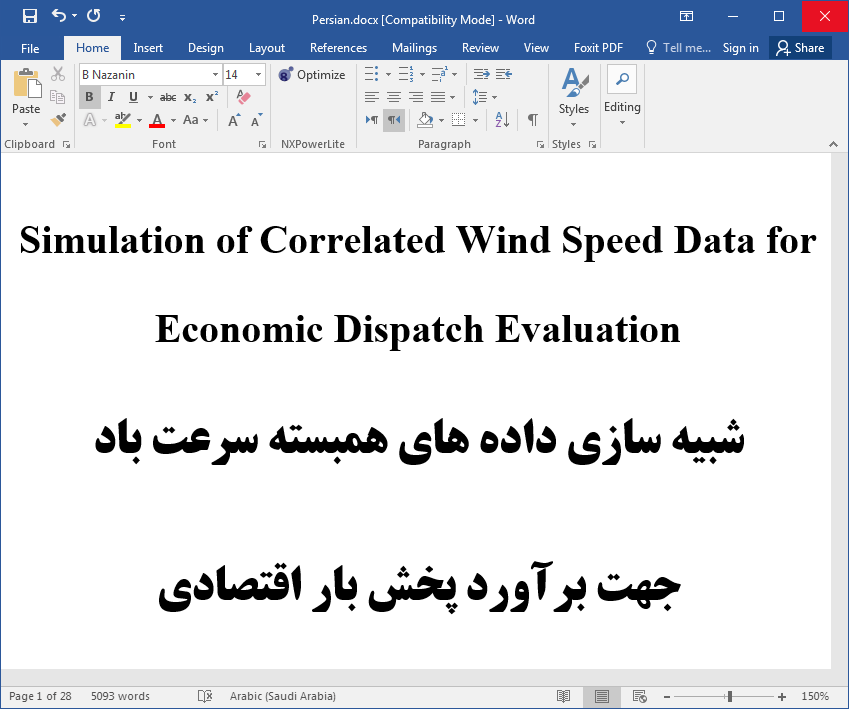شبیه سازی داده های مربوطه سرعت باد برای ارزیابی پخش بار اقتصادی (ED)


25,500 تومانشناسه فایل: 5744
- حجم فایل ورد: 283.4KB حجم پیدیاف: 856.1KB
- فرمت: فایل Word قابل ویرایش و پرینت (DOCx)
- تعداد صفحات فارسی: 28 انگلیسی: 8
- دانشگاه:Departamento de Enxeñería Eléctrica, Universidade de Vigo, Escola de Enxeñería Industrial, Vigo, Galicia, Spain
- ژورنال: IEEE Transactions on Sustainable Energy (1)
چکیده
مسئله مربوط به پخش بار اقتصادی (ED) عبارتند از کاهش هزینه های تولید توان مورد نیاز توسط سیستمهای توان الکتریکی با استفاده از پخش مناسب توان بین ژنراتورهای موجود. مشکلات موجود در پیش بینی تولید انرژی باد بدان معنی است که هزینه های مجازات ذخیره شده باید در هنگام ارزیابی در نظر گرفته شود. وقتی که ارزیابی این هزینهها و ارتباط بین مقادیر سرعت باد با عنوان ورودی دیگر در نظر گرفته شوند، دیگر تجزیه و تحلیل توان خروجی هر توربین باد جداگانه کافی نیست چون آنها هم یک نفوذ جداگانه دارند. این مقاله یک روش جدید برای تولید قدرت انرژی باد همبسته معرفی شده است و توضیح می دهد که چگونه در زمان ارزیابی پخش بار این روش اعمال میشود. یک مطالعه موردی برای آنالیز این ارائه شده که آیا ارتباطات و همبستگی در مسئله تاثیری دارد یا نه؟
مقدمه مقاله
پخش بار اقتصادی (ED) شامل پخش توان تولید شده از طریق ژنراتورهای موجود به منظور به دست آوردن کارآمد ترین، کم هزینه و قابل اعتماد از سیستم قدرت است. این محدودیتهای عملیاتی، در دسترس بودن و قابلیت اطمینان را در نظر می گیرد و هزینهها را به حداقل می رساند تا تقاضای بار و تلفات هم در نظر گرفته شود [1].
بنابراین، نقش کلیدی در برنامه ریزی و عملکرد سیستم قدرت دارد. وقتی که نیروی باد افزایش مییابد، نرخ توان در شبکههای الکتریکی هم افزایش مییابد، پس مسئله ED باید انرژی باد برنامه ریزی شده و هزینه های آن را در نظر بگیرد. با وجودی که پیش بینی توان باد [2] در سال های اخیر به طور قابل توجهی بهبود یافته است، توان باد با دقت کامل برنامه ریزی نشده است. مدلهای کلی استفاده شده برای پیش بینی توان باد مبتنی بر چندین فاکتور هستند: رفتار اتمسفر و داده های موجود مثل پیش بینی آب و هوا (NWP)، داده های تاریخی مثل روند خودکار (AR)، متوسط حرکت کاهنده اتوماتیک (ARMA) و غیره. همبستگی مکانی، هوش مصنوعی و یا ترکیبی از اینها [6]-[3].
بنابراین، با توجه به اینکه توان بادی که در دسترس است و چیزی که برنامه ریزی شده است ممکن است با هم همخوانی نداشته باشد، هزینههای در نظر گرفته شده در مسئله ED طبیعتاً متفاوت است که در ادامه توضیح داده میشود.
ABSTRACT Simulation of Correlated Wind Speed Data for Economic Dispatch Evaluation
The Economic Dispatch problem consists of minimizing the cost of producing the power demanded by an electrical power system, by means of the suitable dispatching of the power production between the available generators. The difficulty in predicting wind power generation means that penalty and reserve costs must be considered when it is included in the evaluation. Analyzing the output power of each wind turbine individually is not enough when evaluating these costs and the correlation between wind speed values must be considered as another input because it also has an influence. This paper introduces a new method for generating correlated wind power values and explains how to apply the method when evaluating Economic Dispatch. A case study is provided to analyze whether considering correlation in the problem has any influence or not.
Introduction
ECONOMIC dispatch (ED) co power to be generated among available generators, consists of dispatching the in order to obtain the most efficient, low-cost, and reliable operation of a power system. It considers operating limits, availability, and reliability, and minimizes costs so that both load demand and losses are supplied [1]. It, therefore, plays a key role in power system planning and operation. As wind power increases its share ratio in electrical networks, the ED problem must consider scheduled wind power and its costs. Even though wind power forecasting methodologies [2] have been considerably improved during the last years, wind power cannot be scheduled with total accuracy. The generally used models for wind power forecasting are based on several factors: current data and atmospheric behavior, such as the numerical weather prediction (NWP); historical data, such as autoregressive (AR), autoregressive moving average (ARMA), etc.; spatial correlation; artificial intelligence; or a combination of these [3]–[6]. Therefore, taking into account that scheduled and available wind power may not coincide, the costs to be considered in the ED problem are different in nature, as will be explained later. The ED problem is solved a priori, which means that the power to be produced is scheduled. Flexible plants can set output power to the required value, so both the scheduled and the produced power values coincide unless the unit is malfunctioning. There are other things to consider when wind power is taken into account because the available and scheduled powers at the corresponding wind turbine (WT) may differ and give rise to costs that must be evaluated. Several types of procedures can be applied to solve the ED problem. Analytical solutions like those in [7] are very difficult to apply when considering wind power correlation so numerical solutions like the ones in [8] are preferred. Therefore, the ED evaluation carried out in this paper is based on four terms that depend on the following: 1) the scheduled power of flexible plants; 2) the scheduled wind power; 3) the difference between available and scheduled wind power, when it is positive; 4) the difference between scheduled and available wind power, when it is positive. From the point of view of the system operator, there is a first term for the cost due to the sum of the power provided by the conventional generators. The second one is due to the amount to be paid to wind power producers according to agreements established with them. A term is included that evaluates the cost of the difference between available and scheduled wind power. These costs include the payment to the wind power producers for not using the available power, which is wasted or diverted to another generation facility like a hydro pumping station. Therefore, the third term is basically related to penalty costs due to not using all the available power in the network, i.e., it evaluates the cost of under-forecasting wind power. On the other hand, if the wind power is over-forecasted, the power requested by the load demand has to be supplied anyway, so the power must be purchased from an alternative source. Therefore, the cost of the reserve power or the cost of the power purchased through an interconnection is evaluated in the fourth term. So, these four terms evaluate the costs in order to solve the ED problem. However, this is a general model to evaluate ED and it is adaptable to all possible situations, so any term can be removed depending on specific cases. Notice that if the total power generated and demanded in an electrical network were not equal, then steady-state security could be affected, because this balance is needed for keeping adequate operating conditions. Thus, the electrical network could be seriously influenced by under- or over-forecasting wind power if the steps towards achieving the balance were not taken into account.
- مقاله درمورد شبیه سازی داده های مربوطه سرعت باد برای ارزیابی پخش بار اقتصادی (ED)
- شبیه سازی داده های مربوطه سرعت باد جهت ارزیابی بازده اقتصادی
- پروژه دانشجویی شبیه سازی داده های مربوطه سرعت باد برای ارزیابی پخش بار اقتصادی (ED)
- بررسی پخش بار اقتصادی جهت شبیه سازی اطلاعات سرعت باد همبسته
- پایان نامه در مورد شبیه سازی داده های مربوطه سرعت باد برای ارزیابی پخش بار اقتصادی (ED)
- تحقیق درباره شبیه سازی داده های مربوطه سرعت باد برای ارزیابی پخش بار اقتصادی (ED)
- مقاله دانشجویی شبیه سازی داده های مربوطه سرعت باد برای ارزیابی پخش بار اقتصادی (ED)
- شبیه سازی داده های مربوطه سرعت باد برای ارزیابی پخش بار اقتصادی (ED) در قالب پاياننامه
- پروپوزال در مورد شبیه سازی داده های مربوطه سرعت باد برای ارزیابی پخش بار اقتصادی (ED)
- گزارش سمینار در مورد شبیه سازی داده های مربوطه سرعت باد برای ارزیابی پخش بار اقتصادی (ED)
- گزارش کارورزی درباره شبیه سازی داده های مربوطه سرعت باد برای ارزیابی پخش بار اقتصادی (ED)
